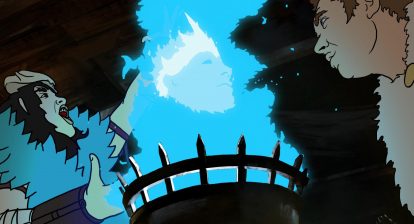While the term “folk horror” is relatively new, the imagery and concepts are familiar to most horror fans. Isolated communities and dark secrets. Ancient rites and forgotten incantations whispered into the wind, a mostly rural landscape where the ancient and the modern collide. Woodlands Dark and Days Bewitched‘s path begins straightforwardly, with an examination of an “Unholy Trinity” of the subgenre’s more prominent examples (1968’s Witchfinder General, 1970’s Blood On Satan’s Claw and 1973’s The Wicker Man). Seeking to better define the term “folk horror” and its parameters shows that the subgenre has a much deeper and richer bloodline, with roots not just in UK cinema, but as perhaps more of an archetypical form that has been adapted worldwide, using the basis of folklore and myth to reflect cultural and era specific anxieties.
It’s a dauntingly broad premise (with an equally imposing 3 hour runtime), but writer/director/noted genre scholar Kier-La Janisse is uniquely equipped to handle the subject matter with the same impeccable level of analytical detail she’s brought to her examinations of horror across other media. Divided into six chapters, the opening trinity of films gives way to an extensive exploration of lesser known British influences, culture clashes, the corruptions of collective narrative, occult and pagan history and examinations of international cinema’s folk horror traditions.
Also See: Seven Movies That Prove Folk Horror Needs More Love
In addition to expertly edited film clips, and Janisse’s own interjections, there is an in depth dream team of interviewees to provide clarification and context to each of the film’s segments. In a festival season that has seen a ton of fan culture focused documentaries, it’s refreshing to see such a diverse scholarly assembly of both genre luminaries (Diabolique magazine’s Samm Deighan and Kat Ellinger, author Alexandra Heller-Nicholas) and specialized historians to illuminate the details of the occult practices and regional folklore (or the revisionist history of same) that are key drivers of this particular branch of horror cinema. The balance between learning and lighter asides gives the film the same edutainment feel as the lectures of the Miskatonic Institute (which writer/director Kier-La Janisse founded in 2010, and served as executive director of until late last year).
If there’s any major fault to be found here, it is that the unusual runtime leaves Woodlands alternately feeling like too much and not quite enough. There’s several hundred recommendations of topical television, fiction and films across the segments, some only briefly shown on screen without further explanation in the interviews. Given the evocative choices of stills, images and clips used to illustrate each example, it’s quite the task to make a list for further viewing without a lot of fast finger pauses and a notebook. The unevenly dispersed animated interludes, traditional songs and poetry readings are clearly meant to add additional atmosphere, but are a distracting tilt into aesthetic excess in an already content rich film.
Also See: Feats of Clay: Seven Horror Movies Inspired by Jewish Folklore & History
In a similar vein, while the extended feature length runtime allows for a vast overview into folk horror’s cultural context and history, there are multiple fascinating perspectives and topics that get a relatively short segment of the total runtime. Such a complex endeavor perhaps would have been better served as a multi part mini series rather than a single film. The writers that are key architects of both Gothic tradition and folk horror, Professor Maisha Wester’s observations on American folk horror being heavily steeped in post Reconstruction racial and economic tensions, or the unique divergences in international entires to the canon (particularly outside of Judeo-Christian majority countries) are all shorter form subtopics that could have easily filled out an entry of a more standard episodic format.
Woodlands Dark and Days Bewitched: A History of Folk Horror is an ambitious and impeccably researched labor of love, with something to offer both die hard fans of this reemerging subgenre, and those only familiar with the folk horror canon’s greatest hits. The segments might be better viewed individually over several sittings, rather than in one go, due to the sheer density of information presented. Despite the academic slant and scope of its approach to the subject matter, Woodlands Dark and Days Bewitched is never less than an engaging experience, if occasionally an overwhelming one.
WICKED RATING: 8/10






